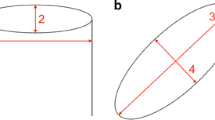Abstract
Purpose
It is relatively well accepted that the long head of the biceps femoris and the semitendinosus both originate from the ischial tuberosity as a common tendon. However, it is also widely known that the biceps femoris is consistently injured more than the semitendinosus. The purpose of this study was to examine the origins of the hamstring muscles, to find an anatomic basis for diagnosis and treatment of injuries of the posterior thigh regions.
Materials and methods
Twenty-eight hips of fourteen adult Japanese cadavers were used in this study. In twenty hips of ten cadavers, the positional relationships among the origins on the ischial tuberosity were examined. In eight hips of four cadavers, histological examination of the origins of the hamstrings was also performed.
Results
The origin of the long head of the biceps femoris adjoined that of the semitendinosus. In the proximal regions of these muscles, the long head consisted of the tendinous part; however, the semitendinosus mainly consisted of the muscular part. Some of the fibers of the biceps tendon extended to fuse with the sacrotuberous ligament. The semimembranosus muscle broadly originated from the lateral surface of the ischial tuberosity.
Conclusion
The origins of the long head of the biceps femoris and the semitendinosus are found to be almost independent, and the tendon of the long head is partly fused with the sacrotuberous ligament. The high incidence of injuries to the long head of the biceps femoris could be explained by these anatomical configurations.



Similar content being viewed by others
References
Opar DA, Williams MD, Shield AJ. Hamstring strain injuries: factors that lead to injury and re-injury. Sports Med. 2012;42:209–26.
Koulouris G, Connell D. Evaluation of the hamstring muscle complex following acute injury. Skeletal Radiol. 2003;32:582–9.
Ripani M, Continenza MA, Cacchio A, Barile A, Parisi A, De Paulis F. The ischiatic region: normal and MRI anatomy. J Sports Med Phys Fitness. 2006;46:468–75.
Lempainen L, Sarimo J, Heikkil J, Mattila K, Orava S. Surgical treatment of partial tears of the proximal origin of the hamstring muscles. Br J Sports Med. 2006;40:688.
Hollinshead W, editor. Anatomy for surgeons. The back and limbs. New York: Hoeber Medical Division; 1969.
Last R (ed). Anatomy: regional and applied. Edinburgh: Churchill Livingstone; 1978.
Romanes G, editor. Cunningham’s textbook of anatomy. 10th ed. London: Oxford University Press; 1964.
Williams P, Bannister L, Berry M, Collins P, Dyson M, Dussek J, et al., editors. Gray’s anatomy. 38th ed. New York: Churchill Livingstone; 1995.
Plank J, Rychlo A. A method for quick decalcification. Zentralblatt f r allgemeine Pathologie und pathologische Anatomie. 1952;89:252.
Sallay PI, Friedman RL, Coogan PG, Garrett WE. Hamstring muscle injuries among water skiers. Am J Sports Med. 1996;24:130.
Miller SL, Gill J, Webb GR. The proximal origin of the hamstrings and surrounding anatomy encountered during repair. A cadaveric study. J Bone Joint Surg. 2007;89:44.
Woodley SJ, Mercer SR. Hamstring muscles: architecture and innervation. Cells Tissues Organs. 2005;179:125–41.
Garrett WE Jr, Nikolaou PK, Ribbeck BM, Glisson RR, Seaber AV. The effect of muscle architecture on the biomechanical failure properties of skeletal muscle under passive extension. Am J Sports Med. 1988;16:7–12.
Bardeen CR. Development and variation of the nerves and the musculature of the inferior extremity and of the neighboring regions of the trunk in man. Am J Anat. 1906;6:259–390.
Fick R. Anatomie und mechanik der gelenke. BARDELEBENS Handbuch der Anatomie des Menschen. Jena: Gustav Fischer. Bd I/1904, Bd II/1911; 1904.
Robinson A, editor. Cunningham’s text-book of anatomy. 5th ed. London: Frowde and Hodder & Stoughton; 1922.
Testut L, Latarjet A, editors. Traité d’anatomie humaine. 9th ed. Paris: Doin & Cie; 1948.
Appleton A. The phylogeny of the sacrotuberous ligament and of certain mammalian thigh muscles. J Anat. 1926;61:511.
Uhlmann K. Phylogenetic origin of the sacrotuberous ligament in man. Z Anat Entwicklungsgesch. 1972;136:1–8.
Chakravarthy J, Ramisetty N, Pimpalnerkar A, Mohtadi N. Surgical repair of complete proximal hamstring tendon ruptures in water skiers and bull riders: a report of four cases and review of the literature. Br J Sports Med. 2005;39:569–72.
Sallay PI, Ballard G, Hamersly S, Schrader M. Subjective and functional outcomes following surgical repair of complete ruptures of the proximal hamstring complex. Orthopedics. 2008;31:1092.
Conflict of interest
All authors, their immediate family, and any research foundation with which they are affiliated did not receive any financial payments or other benefits from any commercial entity related to the subject of this article. The authors declare that they have no conflict of interest.
Author information
Authors and Affiliations
Corresponding author
About this article
Cite this article
Sato, K., Nimura, A., Yamaguchi, K. et al. Anatomical study of the proximal origin of hamstring muscles. J Orthop Sci 17, 614–618 (2012). https://doi.org/10.1007/s00776-012-0243-7
Received:
Accepted:
Published:
Issue Date:
DOI: https://doi.org/10.1007/s00776-012-0243-7




